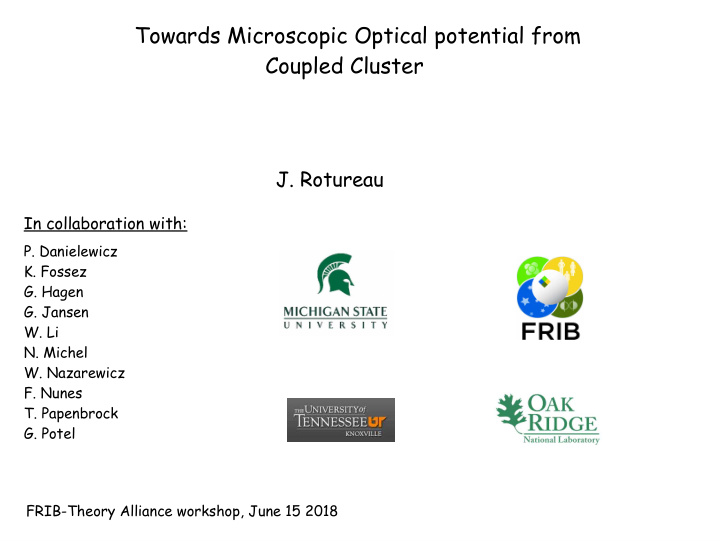



Towards Microscopic Optical potential from Coupled Cluster J. Rotureau In collaboration with: P. Danielewicz K. Fossez G. Hagen G. Jansen W. Li N. Michel W. Nazarewicz F. Nunes T. Papenbrock G. Potel FRIB-Theory Alliance workshop, June 15 2018
Nuclei far from stability structure and reaction channels influence each other Unification of nuclear structure and reactions Near-threshold effects Exotic decay modes 1.867 MeV 5 He+n 2 1.797 MeV 4 He+2n 0.964 MeV 0 6 He Taking into account the coupling to the continuum states is essential for the description of drip-lines nuclei.
Nuclear structure with transfer reactions transfer reactions probe nuclear response to the addition of nucleon information about nuclear structure from: angular differential cross section absolute value position width (in the continuum) A standard approach to reactions: spectroscopic factor cross section from from structure model few-body/reaction models can suffer from inconsistency between the two schemes !
Nucleon-Nucleus Optical Potential
Nucleon-Nucleus Optical Potential Phenomenological local potential (A.J Koning, J. P. Delaroche, NPA 2003)
Feshbach (1958) optical potential in P energy-dependent/non-local/complex
Microscopic Optical Potential * all nucleons are active, chiral-EFT n-n, 3n interactions (taken from W. Nazarewicz, JPG 2016) * Goals: predictive theory for nuclear reactions, reliable/accurate extrapolations for systems far from stability.
Single-particle Green's function
Single-particle Green's function
Single-particle Green's function
Single-particle Green's function Dyson equation nucleon-nucleus potential
Coupled Cluster Theory (G. Hagen, T. Papenbrock, M. Hjorth-Jensen, D. J. Dean, RPP 2014) Exponential ansatz Similarity-transformed Hamiltonian 1p-1h operator Coupled cluster equations 2p-2h operator 1p-1h 2p-2h
Coupled Cluster with the Berggren basis 1p-1h 2p-2h
Coupled Cluster with the Berggren basis
CC(SD) with N 2 LO opt : 16 O and 17 O 17 O 3/2 + 1/2 + 5/2 + PA-CCSD Expt
CC(SD) with N 2 LO opt : 16 O and 17 O 17 O 3/2 + 1/2 + 5/2 + PA-CCSD Expt
CC(SD) with N 2 LO opt : 16 O and 17 O 17 O 3/2 + 1/2 + 5/2 + PA-CCSD Expt Real part of the (diagonal) neutron S-wave potential @ 10 MeV as a function of the number of Lanczos iterations. ( J. R , P. Danielewicz, G. Hagen, F. Nunes, T. Papenbrock, PRC 2017)
CC(SD) with N 2 LO opt : too small absorption Volume integral of the imaginary part 16 O of the neutron s-wave optical potential Expt * calculated optical potential has no absorption below 10 MeV
CC(SD) with N 2 LO opt : too small absorption Volume integral of the imaginary part 16 O of the neutron s-wave optical potential (EOM)-CCSD Expt * calculated optical potential has no absorption below 10 MeV * absorption can be artificially increased by using finite value for η
40 Ca/ 48 Ca N2LOsat interaction (A. Ekström et al, 2015) : 2 and 3-body terms reproduction of binding energies and nuclear radii (taken from G. Hagen et al , 2016)
40 Ca(n,n) 40 Ca PA-CCSD Expt Real part of V(r,r) for the bound states in 41 Ca
40 Ca(n,n) 40 Ca MeV CCSD Expt PA-CCSD Expt Real part of V(r,r) for the bound states in 41 Ca
40 Ca(n,n) 40 Ca @ 5.2 MeV
48 Ca(n,n) 48 Ca E=7.81 MeV CCSD Expt
reaction formalism by G. Potel, F. Nunes, I. Thompson (2015) Differential cross section E pa-ccsd (5/2 - ) = 1.02 MeV for populating the g.s. in 41 Ca. Differential cross section experiment for populating J π =5/2 - in 41 Ca. GF-CC(SD) E exp (7/2 - )= -8.36 MeV E exp (5/2 - )= -5.78 MeV E pa-ccsd (7/2 - )= -7.84 MeV
Microscopic nucleon-nucleus optical potential Coupled Cluster Green’s function with chiral-EFT nn,3n potentials Continuum (Berggren) basis ➔ qualitative agreement with data, but overall lack of absorption ➔ preliminary results for (d,p) reactions Outlook: ➔ CCSD(T) ➔ Use of the dispersion relation starting with the CCGF potential + perturbation... ➔ other chiral-EFT interaction...
Recommend
More recommend